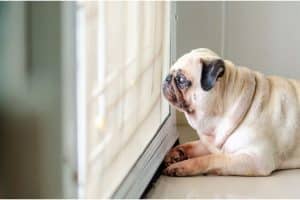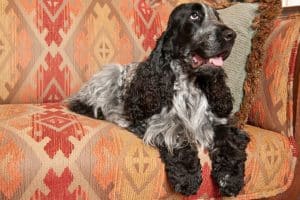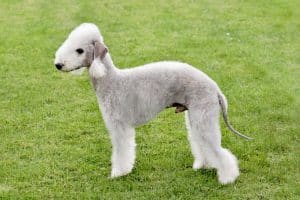Have you found yourself wondering what a Cockador is? Maybe someone mentioned the breed to you and you aren’t sure what they are? Or are you considering adopting a Cockador and want to know more? No matter the reason that brought you here today, we have the answer for you!
Finding out what a Cockador is can be tricky, especially if you have never heard of the breed before.
You head online to find out more but are met with pages and pages of conflicting and contradicting information that leaves you unsure where to turn or who to trust. Frustrated and disappointed you wonder if you will ever find the answers that you need.
Well, no more! Today, we are here with the answers you need. Keep reading to find out what a Cockador is and everything there is to know about this adorable breed.
From their appearance to lifespan and how to train them, we have it all coming up! So get comfy and prepare to become a Cockador expert today.
What Is A Cockador?
A Cockador is a mix between a Cocker Spaniel and a Labrador Retriever. They are an incredibly popular breed, known for their high energy levels and cuddly nature.
Let’s dive straight into our article! A Cockador is a mixed breed, otherwise known as a Sapndor, Cockerdor, or Cocker Spaniel Lab Mix. The relatively new breed is a Cocker Spaniel crossed with a Labrador Retriever.
The medium-sized dog is the perfect companion for anyone who is active. Thanks to the mix of Labrador Retriever and Cocker Spaniel, these dogs love to run! They have high energy levels that are best burned up with long walks, runs through the park, or playtime with their favourite toys.
These dogs are incredibly loyal too. A Cockador will protect and want to be near their family. While they can be protective, Cockadors tend to always be gentle with their owners and family.
It’s the perfect dog if you have young children thanks to its playful nature! You can expect them to interact well with your children, making them wonderful companions for them to play with!
Providing that Cokadors are socialised from a young age, they are wonderful dogs that can interact with other dogs and people with ease. Cockadors are known for their intelligence, resilience, and friendly nature, making them the ideal dog for families!
Not only do they have high energy levels, but these dogs love a cuddle too! You can expect these lovely dogs to jump onto your lap or cuddle next to you on the sofa, it can be hard to pull away from their cuddles too! When you’ve had a long day, they are always there with their soft fur for a lovely cuddle.
Whether you are a family, a couple, or looking for some company, a Cockador is an excellent dog to choose from. There’s a reason this breed is hugely popular! Whether you want a dog to take on long walks, play with children, or have some company, a Cockador is a fantastic choice!
Now that we have established what a Cockador is, let’s dive in a little deeper to see what else there is to know about these beautiful dogs.
A Brief History Of Cockadors
Cockadors are a fairly new breed, becoming popular in the 1980s as hunting dogs. The breed is now commonly kept as family pets.
Compared to other dog breeds, the Cockador is fairly new. There isn’t a great deal known about their origins, but many believe the first hybrid was created in the late 1980s. The hybrid originated in North America, where the dogs were used for hunting.
The mixture of Labrador and Cocker Spaniels made them ideal for this task. However, in recent years, the Cockador has become a popular family pet. This is due to their qualities beyond hunting, like their friendly nature, loyalty, and resilience.
What Do Cockadors Look Like?
Cockadors tend to have wide chests with floppy ears and a strong, athletic build. Their appearance does depend on their lineage, but they always look adorable!
It can be hard to give just one answer when discussing the appearance of crossbreeds. Often, it depends on their lineage. If their parents are not purebred dogs, then you can have other breeds in the mix that will impact the appearance of a Cockador.
A DNA test can be helpful here, helping you to understand more about your Cockador’s genetic makeup. These can be expensive and aren’t always necessary, but they are a good way to learn more about your dog! We recommend these tests if your dog doesn’t look like a Labrador or Cocker Spaniel.
Generally, Cockadors will have an athletic build with wedge-shaped heads that are rounded on top. They will also have strong necks attached to their wide and deep chests. Their ears tend to be floppy with fluff covering them, like Spaniels’ ears.
Cockadors also have strong legs and large feet with big pads. Their tails will be whip-like and have more fur on them, like a purebred Labrador tail.
Cockadors come in a range of colours, usually brown, black, white, red, fawn, or cream single tones. Some Cockadors will have a mixture of these colours too.
How Big Are Cockadors?
Cockadors are medium-sized dogs, usually measuring between 18 to 22 inches depending on their gender.
The size of a Cockador does vary depending on their gender, but they are usually closer in size to a Spaniel than a Labrador. Cockados tend to be medium-sized, ranging from 18 to 22 inches in size once they are fully grown.
Fully grown adult males tend to be 20 to 22 inches tall, whereas female Cockadors tend to be slightly shorter, with an average height of 18 to 20 inches.
The weight of the breed varies depending on the gender too. Male Cockadors tend to weigh between 22 and 50 lbs, while females will weigh less, around 20 to 47 lbs.
These weights are based on a healthy dog. Overweight or underweight Cockadors would weigh less or more than these figures and owners should work with their vets to bring their weight under control.
As obesity can be a health concern for these dogs, Cockadors must be kept on a healthy diet that will maintain their weight.
Now, the size and weight of these dogs do also depend on their genetic makeup. Some Cockadors will be larger like their Labrador parent, while others might be smaller, and closer to the size of a Cocker Spaniel. If the dogs used to create the Cockador are not purebred, this will also impact their size.
How Long Do Cockadors Live For?
Cockadors have an average lifespan of 12 to 15 years, provided they are fit and healthy.
On average, Cockadors can live until they are between 12 and 15 years of age provided they are fit and healthy. Regular exercise, a healthy diet, and regular vet appointments are the best way to ensure that your Cockador lives a long and healthy life.
However, as with all dog breeds, there are some health conditions you will want to be aware of. These conditions impact both Cocker Spaniels and Labrador Retrievers, so can impact the mixed Cockador too. Check out our list of these health conditions below.
- Allergies
- Cataracts
- Epilepsy
- Gastric Dilation Volvulus (GVA) or Bloat
- Hip and elbow dysplasia
- Progressive Retinal Atrophy (PRA)
- Skin infection
How severe these health conditions are can vary from dog to dog, with some being impacted by dodgy breeders. We recommend that you only purchase a dog from a professional and registered breeder.
If you are adopting a dog, be sure to find out as much as you can about the dog’s history beforehand. You don’t want to be hit by any unexpected vet bills!
Are Cockadors Hypoallergenic?
No, Cockadors are not hypoallergenic given the nature of their fur.
Unfortunately, Cockadors are not hypoallergenic as they have the same fur as their parents. Cocker Spaniels and Labradors have dense coats of fur that can grow quite long and are prone to shedding. You can expect to find this fur everywhere!
Even with regular grooming, the shedding of their dander can be harmful to anyone with allergies. The fur will stick to your furniture and clothes, and sometimes get into your food! Even with regular cleaning, we bet you will still find traces of this fire in your home.
While some medications can be bought to help with the symptoms of pet hair allergies, this is not an ideal long-term solution for any pet owner or family. If anyone in your home has allergies to pet hair, then a Cockador is probably not the dog for you.
How Can I Groom A Cockador?
Cockadors need regular brushing to help with their shedding, along with frequent baths and trips to the groomer.
As we mentioned earlier, Cockaodrs are high shedders, so they must be well groomed. You can groom your Cockador by brushing through its fur regularly.
This will help with their shedding and keep their fur soft and knot free. We recommend using a slicker brush or other grooming tools that are recommended by vets.
Try to brush your dog’s fur weekly to keep the shedding under control, especially if they are quite active. It’s amazing what running around or rolling in the grass will do to your dog’s fur!
You will also want to bathe your dog regularly too. It’s best to use an unscented mild shampoo for Cockadors and follow it with a leave-in conditioner. You will also want to brush their teeth and clean their ears regularly to prevent any infections or more serious issues.
A Cockador also needs to have their nails trimmed regularly, especially if they are quite active. You can do this yourself, or you can have a pet groomer do them.
It’s worth taking your Cockador every few months for them to have their fur trimmed, nails trimmed, and any other grooming tasks you would prefer a professional to do. Just make sure they have experience with a Cockador before you drop them off.
Are Cockadors Easy To Train?
Yes, as Cockadors are keen to please their owners, they are easy to train. It’s best to use positive reinforcement when training your Cockador.
Cockadors are relatively easy to train thanks to their nature! Cockadors are intelligent dogs and keen to please their owners. This combination of qualities makes them a dream to train!
Sometimes they can be a little stubborn or try to exhibit dominance, so you will need some patience and to regularly train them. This is no different to any other dog breed!
When training Cockadors, we recommend positive reinforcement. Be sure to add lots of praise and plenty of treats when training them to see positive results.
Cockadors also do well in tracking and smell identification thanks to their genetic makeup. You can use this to your advantage when training and watch as your Cockador is trained in no time!
If you are training your dog with other members of your household, make sure you are all on the same page. Cockadors don’t do well when there are mixed messages, so be sure to agree on how and what you are training your Cockador to do before you start.
Final Thoughts
And there you have everything you need to know about a Cockador! These dogs are created when a Cocker Spaniel and Labrador are bred, creating an adorable dog that works well as a family pet!
The medium-sized dogs can live for a long time in good health providing you care for them properly. They will grow with your family, remaining loyal to you and protective when needed.
Providing that they are specialised early and regularly trained, you can share your home with a loving and well-behaved dog, what more could you want?





